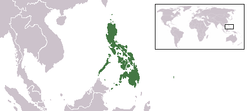Revolutionary Government of the Philippines | |||||||||
|---|---|---|---|---|---|---|---|---|---|
| 1898–1899 | |||||||||
| Anthem: Marcha Nacional Filipina (English: "Philippine National March")[a] | |||||||||
 Territory claimed by the Revolutionary Government of the Philippines in Asia | |||||||||
| Status | Unrecognized state | ||||||||
| Capital | Bacoor (June 1898 – August 1898) Malolos (August 1898 – January 1899) | ||||||||
| Common languages | Spanish, Tagalog | ||||||||
| Religion | Roman Catholicism, Islam, Indigenous Philippine folk religions | ||||||||
| Government | Revolutionary republic | ||||||||
| President | |||||||||
• 1898–1899 | Emilio Aguinaldo | ||||||||
| President of the Cabinet | |||||||||
• 1899 | Apolinario Mabini | ||||||||
| Legislature | None (rule by decree) (June 23 – September 15, 1898) Malolos Congress (from 1898) | ||||||||
| Historical era | Philippine Revolution | ||||||||
• Established | June 23, 1898 | ||||||||
| August 13, 1898 | |||||||||
| December 10, 1898 | |||||||||
| January 23, 1899 | |||||||||
| Currency | Philippine peso | ||||||||
| |||||||||
The Revolutionary Government of the Philippines (Spanish: Gobierno Revolucionario de Filipinas) was a revolutionary government established in the Spanish East Indies on June 23, 1898, during the Spanish–American War, by Emilio Aguinaldo, its initial and only president.[3] The government succeeded a dictatorial government that had been established by Aguinaldo on June 18[4] and was dissolved and replaced by this government upon its establishment.[5][6] This government endured until January 23, 1899, when the proclamation of the Malolos Constitution established an insurgent Philippine Republic government that replaced it.[7][8]
Four governmental departments were initially created, each having several bureaus: foreign relations, marine, and commerce; war and public works; police, justice, instruction, and hygiene; finance, agriculture, and industry.[9] A revolutionary congress was established with power "[t]o watch over the general interest of the Philippine people, and carrying out of the revolutionary laws; to discuss and vote upon said laws; to discuss and approve, prior to their ratification, treaties and loans; to examine and approve the accounts presented annually by the secretary of finance, as well as extraordinary and other taxes which may hereafter be imposed."[10]
On August 14, 1898, two days after the Battle of Manila of the Spanish–American War and about two months after Aguinaldo's proclamation of this revolutionary government, the United States established a military government in the Philippines, with General Merritt acting as military governor.[11]
- ^ "The Philippine National Anthem" (PDF). Balanghay: The Philippine Factsheet. No. 3. May–June. National Commission for Culture and the Arts. 2012.
- ^ Castro, C.A. (2011). Musical Renderings of the Philippine Nation. New Cultural History of Music. Oxford University Press. p. 29. ISBN 978-0-19-987684-6. Retrieved January 18, 2022.
- ^ Duka 2008, pp. 167–174
- ^ Elliott 1917, pp. 491–493 (Appendix E: Aguinaldo's Proclamation of June 18, 1898, Establishing the Dictatorial Government)
- ^ Kalaw 1927, pp. 423–429 (Appendix C.)
- ^ Guevara 1972, p. 35
- ^ Guevara 1972, pp. 120–122 (items 28, size=100, view=image 28a and size=100, view=image 28b)).
- ^ Elliott 1917, pp. 493–497 (Appendix F: Aguinaldo's Proclamation of June 23, Establishing the Revolutionary Government)
- ^ Elliott 1917, pp. 493–494 (Appendix F, Chapter I : Of the Revolutionary Government)
- ^ Elliott 1917, pp. 495–496 (Appendix F, Chapter II : Of the Revolutionary Congress)
- ^ Halstead 1898, pp. 110–112
Cite error: There are <ref group=lower-alpha> tags or {{efn}} templates on this page, but the references will not show without a {{reflist|group=lower-alpha}} template or {{notelist}} template (see the help page).

